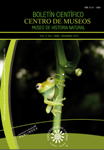Autores/as
Resumen
El control biológico a través de predadores es observado como una alternativa promisoria al control químico de plagas. Phytoseiulus macropilis se ha encontrado asociado a poblaciones del ácaro rayado Tetranychus urticae en plantaciones de fresa en el estado de Minas Gerais, Brasil. En este trabajo se evaluó a través de experimento de olfatometria los efectos subletales de la azadirachtina sobre la capacidad de P. macropilis en detectar volátiles de plantas de fresa infestadas con T. urticae. Los resultados muestran que el ácaro predador P. macropilis puede diferenciar entre olores de plantas de fresa no atacadas y plantas de fresa atacadas por T. urticae. La azadirachtina en la concentración de 0,31 mg i.a/L no interfirió en la respuesta olfativa de P. macropilis alimentado de presas asperjadas.
Palabras clave:
Citas
BERNAYS, A. & CHAPMAN, R., 1994. Behavior: The process of host-plant selection. Pag. 95-205 in A. Bernays y R. Chapman, editors. Host-plant selection by phytophagous insects. Chapman & Hall New York, USA.
CHEN, F., RO, D.K., PETRI, J., GERSHENSON, J., BOHLMANN, J., PICHERSKY, E. & THOLL, D., 2004. Characterisation of root-specific Arabidopsis terpene synthase responsible for the formation of the volatile monoterpene 1,8- cineole. Plant Physiol. 135: 1956-1966.
DE MORAES, C.M., LEIWS, W.J., PARE, P.W., ALBORN, H.T. & TUMLINSON, J.H., 1998. Herbivore-infested plants selectively attract parasitoids. Nature, 393: 570-573.
FADINI, M.A.M., 2005. Interações em teias alimentares de ácaros no morangueiro (Fragaria x ananassa). Tese doutorado. Universidade Federal de Viçosa. Viçosa. 78p.
KEESLER, A. & BALDWIN, I.T., 2001. Defensive function of herbivore-induced plant volatile emissions in nature. Science 291: 2141-2144
KLUDSEN, J.T., TOLISTEN, L. & BERGSTRON, L.G., 1993. Floral scents- a checklist of volatile compounds isolated by head-space techniques. Phytochemistry. 33: 253-280
LANDOLT, T.P.J. & PHILLIPS, T.W., 1997. Host plant influence on sex pheromone behaviour. Ann. Rev. Entomol. 42: 371-391.
MARIN, J.C. & CESPEDES, C.L., 2007. Compuestos volátiles de plantas. Origen, emisión, efectos, análisis y aplicaciones al agro. Rev. Fitotec. Mex. 30 (4): 327-351.
OVERMEER, W.P.J. & VAN ZON, A.Q., 1982. A standardized method for testing the side effect of pesticides on the predaceous mite, Amblyseius potentillae (Acari: Phytoseiidae). Entomophaga 27: 357-364.
PALLINI, A., JANSSEN, A. & SABELIS, M.W., 1997. Odour- mediated responses phytophagous mites to conspecific and heterospecific competitors. Oecologia 110: 179-185.
POTTER, C., 1952. An improved laboratory apparatus for applying direct sprays and surface films, with data on the electrostatic charge on atomized spray fims. Annals of Applied Biology 39: 1-29.
PRICER, P.W., BOUTON, C.E., GROSS, P., McPHERON, B.A., THOMPSON, J.N. & WEIS, A.E., 1980. Interactions among three trophic levels: influence of plants on interactions between insect herbivores and natural enemies. Annual Review of Ecology and Systematics, 11: 41-65.
RAMIREZ, C.C., FUENTES, E., RODRÍGUEZ, L.C. & NIEMEYER, H.M., 2000. Pseudoreplication and its frecuency in olfatometric laboratory studies. Journal of Chemical Ecology 26: 1423- 1431.
REIS, P.R., CHIAVEGATO, L.G., MORAES, G.J., ALVES, E.B. & SOUSA, E.O., 1998. Seletividade de agroquímicos ao ácaro predador Iphiseiodes zuluagai Denmark & Muma (Acari: Phytoseiidae). Anais da Sociedade Entomológica do Brasil 27: 265-274.
ROSE, U.S.R., MANUKIAN, A., HEATH, R.R. & TUMLINSON, J.H., 1996. Volatile semiochemicals released from undamaged cotton leaves. Plant Physiol. 111: 487-495.
SABELIS, M.W., VAN BAALEN, M., BAKKER, F.M., BRUIN, J., DRUKKER, B., EGAS, M., JANSSEN, A.R.M., LESNA, I.K., PELS, B., VAN RIJN, P.C.J. & SCUTAREANU, P., 1999. The evolution of direct and indirect plant defence against herbivorous arthropods. In: Herbivores: between Plants and Predators, H. Olff, V.K. Brown & R.H. Drent (eds), Blackwell Scientific Publications, Oxford . pp 109-166.
SOKAL, R.R. & ROHLF, F.J., 1995. Biometry: The principles and practice of statistics in biological research. 3rd edition. W.H. Freeman, New York. 887p.
SOTO, A., 2009. Manejo alternativo de ácaros em morango e tomate. Dissertação de doutorado. Universidade Federal de Viçosa, Viçosa, Brasil. 128p.
SOTO, A.; VENZON, M. & PALLINI, A., 2011. Integración de control biológico y de productos alternativos contra Tetranychus urticae (Acari: Tetranychidae). Revista U.D.C.A. Actualidad y Divulgación Científica, 14 (1): 23- 29.
STEEGHS, M., BAIS, H.P.,DE GOUW, J., GOLDAN, P., KUSTER, W., NORTHWAY, M., FALL, R. & VIVANCO, J.M., 2004. Proton-transfer-reaction mass spectrometry (PTR-MS) as a new tool for real time analysis of root-secreted volatile organic compounds (VOCs) in Arabidopsis thaliana. Plant Physiol. 135: 47-58
TAKABAYASHI, J. & DICKE, M., 1996. Plant-carnivore mutualism through herbivore-induced carnivore attractants. Plant Science. 1: 109-113.
TEODORO, A.V., 2003. Interferências subletais de acaricidas em uma teia alimentar de cafeeiro. Dissertação de mestrado. Universidade Federal de Viçosa, Viçosa. 60p.
ZHANG, Z.Q., SANDERSON, J.P. & NYROP, J.P., 1992. Foraging time and spatial patterns of predation in experimental populations. A comparative study of three mite predator prey systems (Acari: Phytoseiidae, Tetranychidae). Oecologia 90: 185-196.
ZHANG, Z.Q. & SANDERSON, J.P., 1993. Behavioral responses to prey density by three acarine predator species whit different degrees of polyphagy. Oecologia 96: 147-156.
VAN ZANDT, P.A. & AGRAWAL, A.A., 2004. Specificity of induced plant responses to specialist herbivores of the common milkweed Asclepias syriaca. Oikos, 104: 401-409.
VENZON, M., JANSSEN, A. & SABELIS, M.W., 1999. Attraction of a generalist predator towards herbivore-infested plants. Entomologia Experimentalis et Applicata. 93: 305-314.

 PDF
PDF
 FLIP
FLIP
















